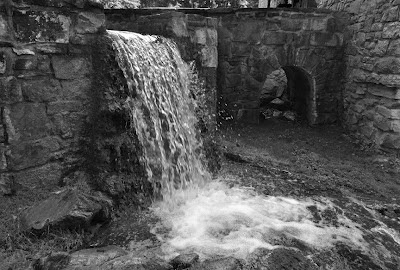Today's post was written and photographed by my husband Bob, a veteran photo journalist, who taught photography on the college level for many years.
For every photograph, there is one correct exposure. With an adjustable camera, you have two ways of controlling the light to achieve that result. Your exposure controls are the shutter speed (duration) and aperture or f/stop (intensity). Duration plus intensity controls exposure.
Think of it like filling a pitcher of water. You can turn on the faucet so a trickle of water comes out and it will take a long time to fill the pitcher. Or, you can turn the tap all the way open and fill it fast.
It's the same way with light. You can open the lens up by using a wide aperture setting like f/4 and let a lot of light in like the open tap. Therefore, you need a short exposure duration to keep too much light from filling up your picture pitcher, so shutter speeds like 1/2000th of a second will be used.Or, you can let in only a trickle of light by using an f/stop like f/16 or f/22), but the shutter will be open for a longer time, like 1/4th or 1/2 second so the trickle of light can fill the exposure up.
The shutter speed can also affect the way that moving objects are reproduced. In simple terms, the motion can be frozen, like a football player flying in mid-air, or it can be blurred, where the moving object creates a streak instead of a clear and sharp image.
The first photo of the waterfall shows the blurred motion affect. The exposure time was 1/4th of a second, which caused the flowing water to look almost like ice. It can sometimes help to visually carry the sense of the subject's motion, like this stream, into a still image.
The second photo was taken at a shutter speed of 1/500th of a second. If you look closely, you will see the water drops frozen in flight from the waterfall, and can see the different way the moving water is reproduced compared to the first photo.
Check your camera's owners manual to see if your camera allows you to manually adjust the shutter and aperture settings. Remember that when you change one of the settings (shutter or aperture) to get the affect you want, you also have to set the other one accordingly. Some cameras, particularly digital SLR's, have the choice of aperture-prefered or shutter-prefered settings (marked A or S) that let you make your choice and then automatically set the other exposure setting for you. Also, use a camera support like a tripod for best results when using long exposures (like 1/15th or 1/2 second) unless you are experienced at handling your camera in a steady manner.
















































8 comments:
Thanks a million, Bob. Your post is a real life-saver!
Regards from India.
This is fantastic information Cindy. I hope we see Bob as a regular on your page helping those of us that are mediocre photographers.
I've been working lately to try to improve my photography and really appreciate the tutorial!! ~ Blessings
http://gracescraps.blogspot.com/
Will your hubby give an on-line class???? Please!!!!! I love these tips so much, Cindy!
TFS...I appreciate the tip!
lov'in this tip!!!! love your sb pages too!!
Thanks for sharing this!!! :D
What a lovely story and LO ,Photo's are also great
Post a Comment